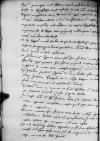Venit huc 25 huius hic Vestrae Reverendissimae Dominationis nuntius ipsoque die litterae distributae sunt. ⌊Maiestati reginali⌋ copiam illam ⌊⌋ ad ⌊dominum de Nassaw⌋ interpretatus sum superinscribed⌈sumsum superinscribed⌉, placuit suae maiestati tanta Vestrae Reverendissimae Dominationis diligentia, hoc tamen ad rem pertinens cupit, ut domino ⌊Georgio Hegel⌋ scribatur paper damaged⌈[r]r paper damaged⌉, quo habend written over it⌈itendend written over it⌉o litteras ... illegible⌈...... illegible⌉ a domino comite suae maiestati (per me, si libet) legendas offerat, priusquam in ⌊Prussiam⌋ Dominationi Vestrae Reverendissimae ferantur, ne mora obsit, ut plerumque solet.
Christianam et paternam Vestrae Reverendissimae Dominationis admonitionem obvio pectore animoque gratissimo accipio, licet, ut verum, quod sentio, dicam superinscribed⌈dicamdicam superinscribed⌉, plus semper crapula quam ⌊Venus⌋ mihi nocuit, illa enim hanc peperit, utraque autem infirmum corpus facit, primas tamen partes crapulae do, video enim apertis oculis, quo me deduxerit. Ex illa enim capitis mei vertigine secutus est hactenus mirabilis tinnitus in altera aure, cum perpetuo pituitae per nervos defluxu. Non tamen in toto me medicis dedi, solis decoctionibus herbarum loco sirupi usus sum fidens naturae fortiori; consulunt, ut post festa minuam sanguinem. Interim anima, cui Reverendissima Dominatio Vestra consulere videtur plus quam corpori, per veram contritionem curetur.
⌊Sculptor⌋ ille quoque aeger fuit hoc tempore, ob hoc non paravit illa insignia huc usque, verum infra 15 dies promittit fore parata.
 AAWO, AB, D. 4, f. 103v
AAWO, AB, D. 4, f. 103v
Serenissimi ⌊principes⌋ mei determinarunt post dominicam conductus hidden by binding⌈[ctus]ctus hidden by binding⌉ Paschae in ⌊Czyestochowo⌋ proficisci, timeo autem ne podagra hidden by binding⌈[ra]ra hidden by binding⌉ regis impediat eam devotionem. Quod si Vestra Reverendissima Dominatio velit hidden by binding⌈[t]t hidden by binding⌉ ad eorum maiestates written over s⌈stestes written over s⌉ mittere nuntium, ut speratur, cum nescio quo hidden by binding⌈[uo]uo hidden by binding⌉ unguento, consulto ordinabitur, ut versus ⌊Czyestochowo hidden by binding⌈[o]o hidden by binding⌉⌋ inquirendo de rege eat, quandoquidem audio parum extra rectam viam fore iter etc.
Dominus ⌊Georgius Hegel⌋ male habet ex pituitae descensu per totum hidden by binding⌈[otum]otum hidden by binding⌉ corpus semperque calores patitur, dominus Deus virum hidden by binding⌈[um]um hidden by binding⌉ bonum incolumitati restituat.
Dominus ⌊Fabianus Czema⌋ promisit se superinscribed⌈sese superinscribed⌉ hic futurum ante finem hidden by binding⌈[inem]inem hidden by binding⌉ Aprilis, ipse poterit huc ferre, si quid mittere volet hidden by binding⌈[t]t hidden by binding⌉ Vestra Reverendissima Dominatio, nec erit necesse proprium nuntium mittere hidden by binding⌈[tere]tere hidden by binding⌉. Ex ⌊Italia⌋ scribunt ⌊caesarem⌋ in ⌊Lumbardia⌋ fore men hidden by binding⌈[n]n hidden by binding⌉se hidden by binding⌈[e]e hidden by binding⌉ Maii, interim ⌊Neapoli⌋ et in aliis regni civitatibus hidden by binding⌈[ibus]ibus hidden by binding⌉ fiunt munitiones ad resistendum ⌊Turcis⌋.
Victorem iuvi in una re, ut finem habeat cum scriba seu secretario ⌊consulum Cracoviensium⌋ super debito.
In causa autem cum episcopo statur, licet sit citatus, tamen hidden by binding⌈[en]en hidden by binding⌉ nemo apparet accusator, nescio quid sequetur, ipse hidden by binding⌈[e]e hidden by binding⌉ stat in negativa.
Rumor incertus hic sparsus erat de 80 milibus caesaris hidden by binding⌈[is]is hidden by binding⌉ militibus a ⌊Gallis⌋ nescio ubi prostratis, sed nec nemo hidden by binding⌈[mo]mo hidden by binding⌉ credit, praeterea hoc tempore nil certi restat.
De nostra nobiliumque bellica expeditione futura aestate sapien hidden by binding⌈[ien]ien hidden by binding⌉tiores nil fore existimant, soli illi magnanimi et magni hidden by binding⌈[ni]ni hidden by binding⌉crepi minitando bellum sperant.
 AAWO, AB, D. 4, f. 104r
AAWO, AB, D. 4, f. 104r
21 huius scripsi Dominationi Vestrae Reverendissimae ea, quae se offerebant per nuntium ⌊domini de Baysen⌋.
Commendo me solitae gratiae Dominationis Vestrae Reverendissimae, quae felicissime valeat.




 AAWO, AB, D. 4, f. 104v
AAWO, AB, D. 4, f. 104v